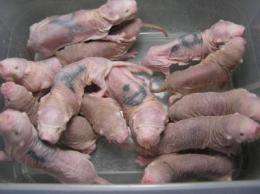Scientists find differences in naked mole rat's protein disposers

The naked mole rat, a curiously strange, hairless rodent, lives many years longer than any other mouse or rat. Scientists at The University of Texas Health Science Center San Antonio's Barshop Institute of Longevity and Aging Studies continue to explore this mystery.
On May 2 a Barshop Institute team reported that the naked mole rat's cellular machines for protein disposal — called proteasome assemblies — differ in composition from those of other short-lived rodents. The study is in the journal PLoS ONE.
This is the first report of the molecular mechanisms that underlie the naked mole-rat's superior ability to maintain protein integrity. "More effective removal of damaged proteins within the cell would enable the animal to be able to maintain good function and is likely to contribute to its excellent maintenance of good health well into its third decade of life," said Rochelle Buffenstein, Ph.D., of the Barshop Institute. Dr. Buffenstein is a professor of physiology and cellular and structural biology in the School of Medicine at the UT Health Science Center.
Protein integrity
Dr. Buffenstein and her research team in 2009 reported that the naked mole-rat maintains exceptional protein integrity throughout its long and healthy life. In the new study, the team found a greater number of proteasomes and higher protein-disposal activity in naked mole-rat liver cells.
The Barshop Institute scientists, including lead author Karl Rodriguez, Ph.D., postdoctoral fellow, and Yael Edrey, graduate student, also found large numbers of immunoproteasomes in the liver cells — a bit of a surprise because these protein disposers, which remove antigens after presentation in the immune system, are more commonly found in the spleen and thymus.
"Given the high levels of oxidative damage routinely seen in liver tissue of naked mole-rats, it is likely that, in the liver, these immunoproteasomes may play a critical role in the processing of oxidatively damaged proteins," Dr. Buffenstein said.
Oxidative stress
Oxygen is a reactive molecule, rusting unsealed metals and darkening fruit. In the body over time, it is thought to cause an accumulation of damage leading to functional decline, diseases and aging. This is called the oxidative stress theory of aging.
Naked mole-rats, which live underground in the wild, exhibit high levels of oxidative stress even at a young age, yet do not show many signs of age-related decline until very late in life.
"The composition of proteasomes and the presence of immunoproteasomes in the liver are key pieces of the jigsaw puzzle evaluating how naked mole-rats preserve health span well into their third decade of life," Dr. Buffenstein said.

















